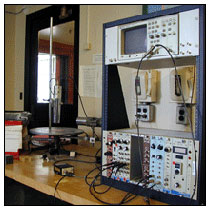|


The scattering of high-energy photons by electrons.
High-energy (662 keV) photons in a collimated
beam from a radioactive 137 Cs source are scattered
from electrons in a target which is itself a scintillation
counter which detects the recoil electron. The
scattered photons are detected in a second scintillation
counter. The distribution in size of pulses from
either the target or the scatter counter are recorded
by a multichannel analyzer gated by pulses from
a coincidence circuit activated by coincident
pulses from the two detectors. In the first part
of the experiment both scintillators are NaI crystals,
and the energies of the scattered photons and
the recoil electrons are measured as functions
of the scattering angle; the results are compared
with the theory of Compton scattering.
In the second part the target
is a plastic scintillator, and the relative intensities
of scattered photons are recorded at several scattering
angles. The results, normalized to a separate
measurement of the total scattering cross section
of the plastic scintillator, are used to derive
the differential scattering cross section; the
results are compared withf the Thomson and the
Klein-Nishina formulas for the scattering of photons
by free electrons.
Student Wiki: Compton Scattering
Download
Lab Guide in PDF format
(certificates
required)

- 1927 Nobel Prize to A.H. Compton for his Discoveries and Research in the Field of X-Ray Spectroscopy
- A.H. Compton,
Phys. Rev., 21, 715 (1923).
- A.H. Compton, "The
Spectrum of Scattered X-Rays," Phys. Rev., 22, 409-413, (1923).
- A.H. Compton, "A Quantum Theory of the Scattering of X-Rays by Light Elements," Phys. Rev., 21, 483-502, (1922).
- R. Hofstadter and J.A. McIntyre, "Measurement of Gamma-Ray Energies with Two Crystals in Coincidence,"
Phys. Rev., 78, 619-620 (1950).
- N.H. Lazar, R.C. Davis, and P.R. Bell, "Peak Effeciency of NaI," Nucleonics, 14, 52 (April 1956).
- A.C. Melissinos, Experiments in Modern
Physics, (Academic Press, San Diego, 1966), "Compton
Scattering," 253-265.
- R.P. Garner and K. Verghese, "On the Solid Angle Subtended by a Circular Disc,"
Nucl. Instrum. Methods, 93, 163-167 (1971).
- J. Higbie, "Undergraduate Relativity Experiment," Am. J. of Phys., 42, 642-644 (1974).
- G.F. Knoll, Radiation Detection and Measurement (John Wiley, New York, 2000), "Optimization
of Counting Experiments," pp.92-95
- G.F. Knoll, Radiation Detection and Measurement (John Wiley, New York, 2000), "Radiation
Spectroscopy with Scintillators," pp.306-355

- Canberra
2000 NIM Bin and Power Supply
- Canberra 802
Scintillation Detector [Na(Ti) Detectors]
- Canberra
805 Scintillation Detector Preamplifier
- Canberra
3002 HV Power Supply (3002D is a newer digital version)
- Canberra 2126 Constant Fraction
Discriminator
- Ortec 533
Dual Sum and Invert Amplifier
- Ortec 418A
Universal Coincidence
|